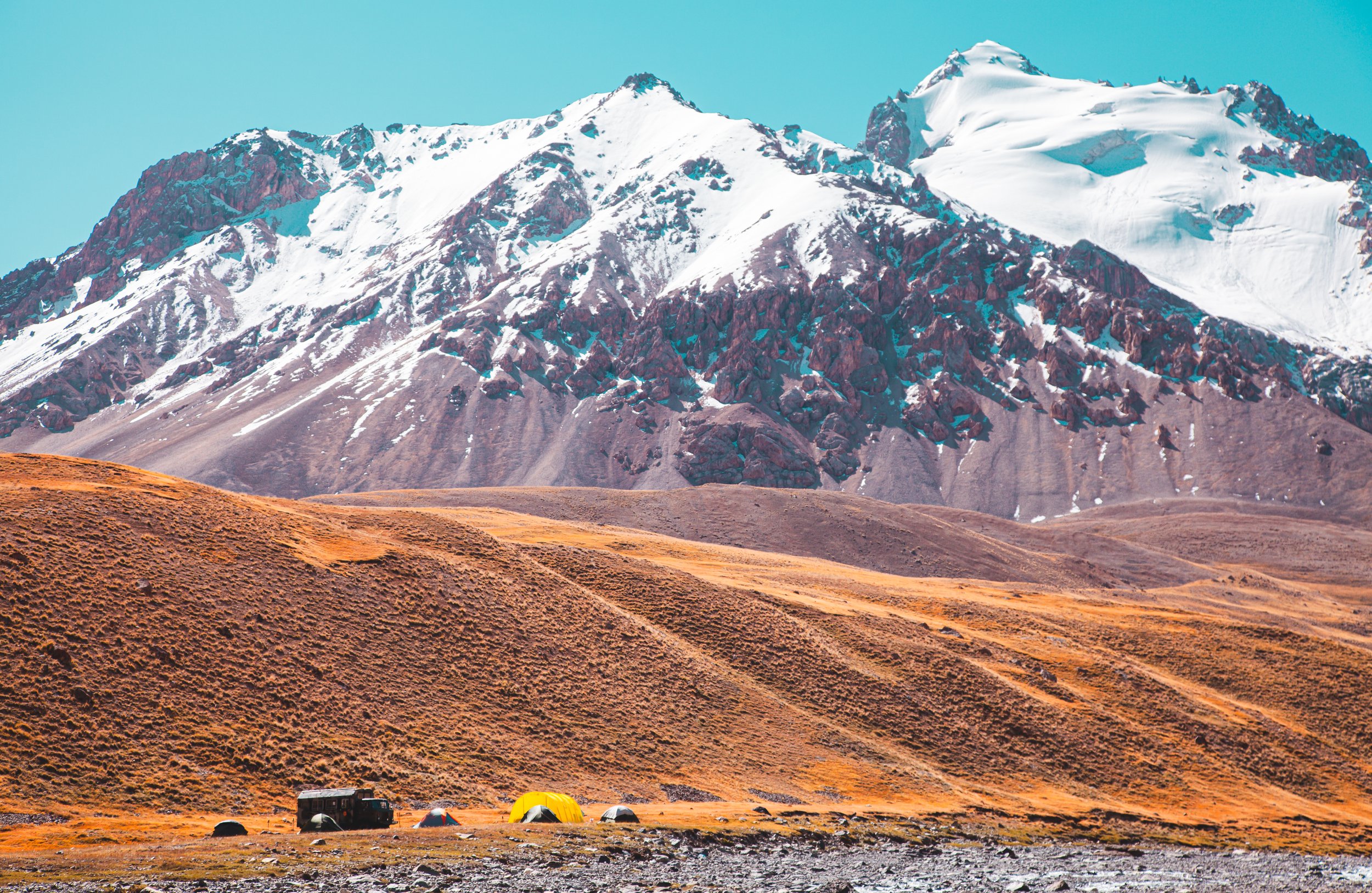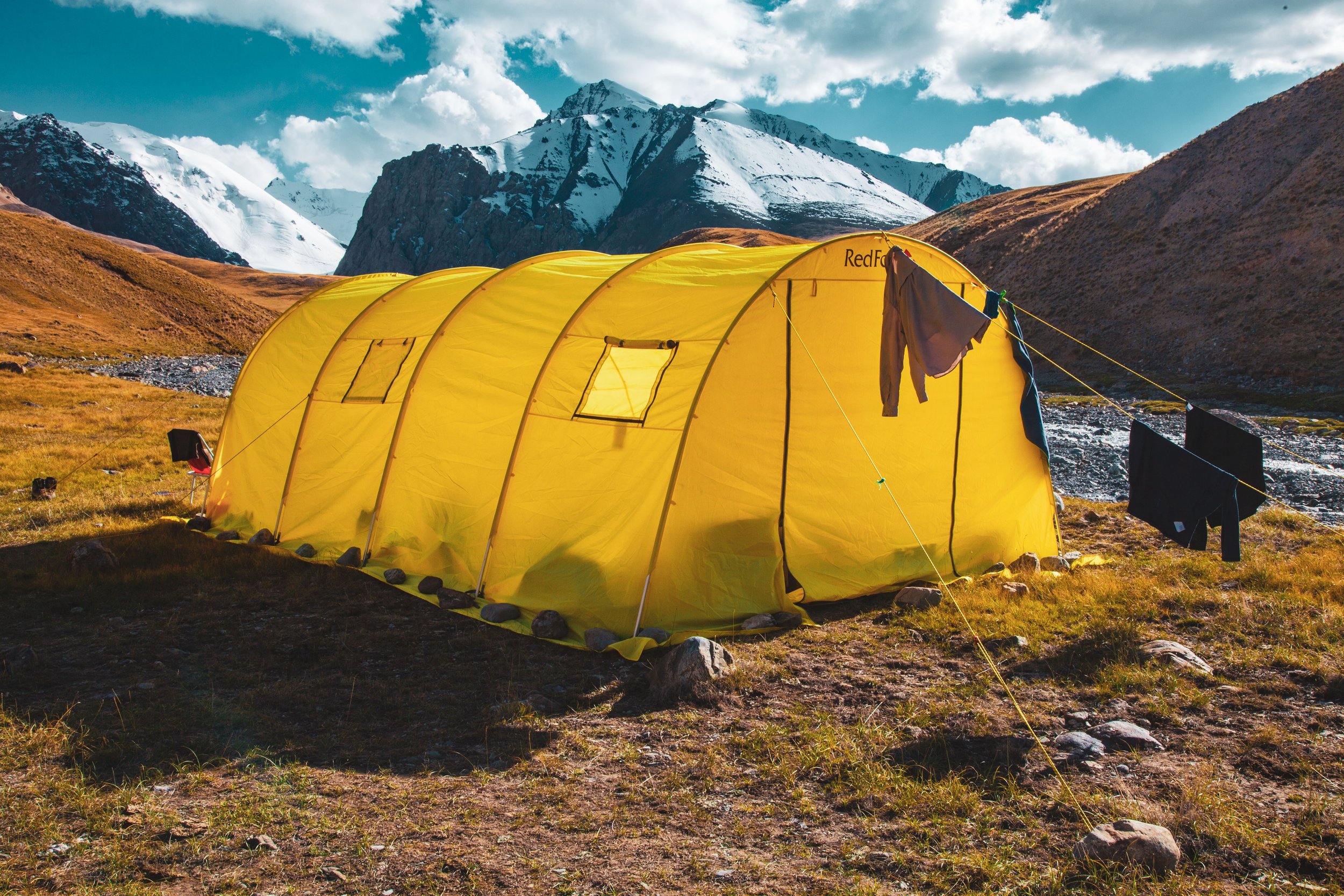
Celestial peaks:
Summiting unclimbed mountains in Kyrgyzstan
About the author: Chris Shirley MA FRGS
A former Captain in the Royal Marines, Chris has been an advisor on the BBC’s High Risk and News Safety team, has led the risk management function in an international media charity, and has been an international disaster responder with Re:Act for a number of years.
He holds a master’s degree in business management, has travelled in over 60 countries, is a fellow of the Royal Geographical Society (FRGS), is a Guinness World Record holder, has rowed across the Atlantic in a 5-person team, completed the Marathon des Sables, Ironman triathlons, and many ultra-distance events.
Baby giraffes are born headfirst and not breathing.
It’s the two-metre fall that breaks the umbilical cord and the moment that their head hits the ground that activates the baby’s sympathetic nervous system and it breathes for the first time.
This is often how I feel when entering the outdoor arena; it takes me a few hours to remember how to best live somewhere like this.
For someone that’s spent a large portion of their adult life in the outdoors, I sometimes wonder if my ability to thrive in the outdoors environment should come on quicker - or if it will always take that time for my head to hit the floor before my body wakes up. Either way, the transition from city to wilderness is something I want to experience for as long as I can.
In Autumn 2019, I was honoured to lead an expedition to climb virgin peaks in a remote corner of central Asia: Kyrgyzstan. The country was different from many other mountain environments: A big temperature range and high-altitude base camp meant that acute mountain sickness, dehydration and cramps were all ever-present in this epically beautiful landscape.

The country
For those that have never heard of Kyrgyzstan, it’s a mountainous central Asian country that is roughly four-fifths the size of the UK but with a population noticeably less than London.
It is landlocked and nestled between China, Kazakhstan, Tajikistan and Uzbekistan – with most of the population living in rural areas around the cities of the capital Bishkek and Osh.
The country is home to the ‘Tien Shan’ mountain range (Chinese meaning heavenly or celestial mountains) that run for 1500 miles from China through Kazakhstan and Tajikistan to Kyrgyzstan. The highest peak in the Tien Shan is Victory peak – at 7439m located on the Kyrgyzstan and Chinese border however the range is home to peaks in the 4000m, 5000m and 6000m zones.
The country is also home to Issy Kul lake, a large inland lake over 100 miles long.
Arrival in country and transit to the heavenly mountains
I fly to Bishkek and transit to a guesthouse in the capital and await the remaining team members. We’ve still got a few days before we start heading to the mountains so check out the sights, culture and beauty of capital.
Flights to the country come via Moscow generally with transit times between 12-15 hours (including the stop times) to Bishkek and visas are easy to obtain (the country helpfully operates a list of visa exempt countries for stays below 60 days).
The team comprises of people with vastly different levels of mountaineering and expedition experience; however, all have bags of enthusiasm for hitting a first ascent. Knowing that no one else has ever summitted a mountain that you’re scaling is a huge draw.
We drive to a lovely family-run guesthouse near to the giant Issy Kul lake and spend a comfortable night chatting with each other and the staff. Spying a well-stocked gift shop and knowing we’ll be coming back to the same place stops me from buying anything unnecessary.
That night, we transfer the gear to a large 4x4 type vehicle and over dinner, chat about the next stage where we’ll be joined by a sizable support crew comprising of porters, cooks, guides and drivers. The route takes us high into the Tien Shan mountain range as well as off-road, so vehicle packing has to be well-planned for everyone’s safety and a comfortable journey. Our vehicle is an old soviet Army truck that is built for hard terrain however keeps us guessing when it suffers some running issues.
We make the journey in good time and transition to driving off road. The area is home to a sparse population of semi-nomadic families and farmers who graze cattle on the area,
After hours of bumpy off-road driving, we arrive at our pre-planned valley around 3600m and start setting up our base camp location. The local staff are an expert crew and get to work like an F1 crew
ENTRANCE TO THE MOUNTAIN ARENA
Basing ourselves in a valley entrance, we started by surveying the local area to better understand what was around us to familiarise the team for the upcoming days and get everyone used to carrying weighted packs again. From a safety perspective, myself (the expedition leader) and the International Field Mountain Guide Association-qualified (IFMGA) mountain guide are able to dynamically assess the arena and update our team with slightly amended contingency plans.
First success
Our first mountain is a beautiful snow-covered peak with a low level of technicality. To get close enough, we set up an advance base camp (ABC) nearer to the mountain so that we can start early enough. This means enlisting support from our team of porters so we can move all of our gear and food in one go to set up before nightfall and the onset of cold weather.
We’re a few hundred metres higher than our normal base camp at ABC so ensure we talk about recognising the symptoms of acute mountain sickness (AMS) and check everyone’s oxygen saturation levels. We’ve planned to sleep 2 people per tent and have everyone close enough that they can communicate in an emergency but also so that we’re not all in the same place in case something happens (rockfall for example).
We have to cross a number of crevasses via our collective weight on snow bridges. Trudging through ankle deep snow is tiring at first, however knowing you’re walking towards an unclaimed peak is a huge morale boost meaning our team is driving up at a fast rate.
We hit the summit of 4789m and are ecstatic at getting the first peak in the bag. We return to ABC and over a hot dinner, chat ecstatically over what we’d call the mountain if we were lucky enough to name it. After much discussion, a bottle of Russian vodka is produced by the staff and we toast the end of the first day. Ironically, the name of the vodka – ‘Kochevnik’ (кочевник
In Russian) – meaning ‘Bedouin’ or ‘nomad’, proves the perfect name for the peak and so ‘Mount Kochevnik’ gains it colloquial name amongst the team.
Second mountain
Our next mountain is further away and requires a longer walk to its base. We wake up whilst it’s still dark and cold, and set off over rolling hills to get to the mountain – chatting like excited kids despite the early start.
The mountain is rocky for most of the early ascent meaning that we can move nice and fast – gaining height. We reach the snow line and the route becomes mildly more technical than the day before, with traverses around and over rocks.
After a few more hours, we arrive at the summit at 4446m and take in the incredible views. The peak has the most stunning panorama overlooking a number of other mountains – making it an absolute joy to behold.
Day off at the high-altitude lakes
The team is in need of a rest day, so instead of unnecessarily milling around base camp we look for interesting things on the map and find a number of lakes around 3900m high! To make the day count towards our recovery – we pack our swimming gear, wet weather gear and a picnic and set-off.
After a few hours of walking across the rugged terrain, we reach the lakes – which are surrounded by incredible snow-covered peaks. We set up a small camp from the chilly wind and start tucking into a delicious packed lunch.
Unsurprisingly, the water is bracingly cold. We take it in turns to get in so that there is support in case anyone has a bad reaction to the cold water.
Final summit
With a more confident, practiced and conditioned team, we go for a more challenging peak that requires the most confidence. To do this, we must spend a night back in ABC and need to be up early and on the mountain before sunrise.
The team comes to the main gear tent before 5am so we can have breakfast together and do any final gear and people checks.
We bag our final peak - the highest yet at 4842m - and celebrate with photos of the incredible sights. The team is jubilant at having fitted 3 peaks into such a short time and so we have high fives and congratulate each other on a job well done. More summit photos are taken and after radioing down to base camp, we set about the slow trundle back down for hot food and celebrations!
homeward bound
With 3 peaks in the bag and some incredible outdoors time, we pack up and drive out of the area. Our 4x4 vehicle is fully packed and the whole team is practically falling asleep in the warmth. As we drive past the mountains and the lakes we’ve visited, we trade stories of our favourite parts of the week and look forward to a comfortable bed and looking around the tourist sites at Issy Kul lake.
After thanking and saying goodbye to our support team, we head back to Bishkek and have final team dinner at a pizza restaurant and toast everyone’s return back home – with a flurry of summits and a first for the entire team.










